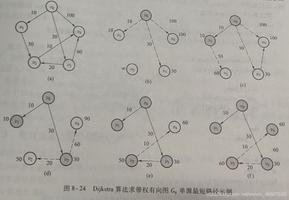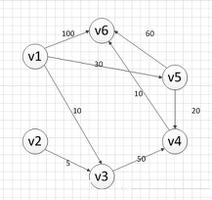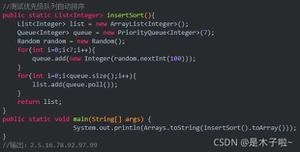C++求所有顶点之间的最短路径(用Dijkstra算法)
本文实例为大家分享了C++求所有顶点之间最短路径的具体代码,供大家参考,具体内容如下
一、思路: 不能出现负权值的边
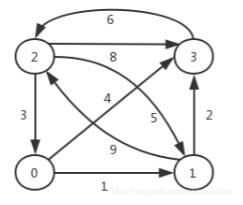
(1)轮流以每一个顶点为源点,重复执行Dijkstra算法n次,就可以求得每一对顶点之间的最短路径及最短路径长度,总的执行时间为O(n的3次方)
(2)另一种方法:用Floyd算法,总的执行时间为O(n的3次方)(另一文章会写)
二、实现程序:
1.Graph.h:有向图
#ifndef Graph_h
#define Graph_h
#include <iostream>
using namespace std;
const int DefaultVertices = 30;
template <class T, class E>
struct Edge { // 边结点的定义
int dest; // 边的另一顶点位置
E cost; // 表上的权值
Edge<T, E> *link; // 下一条边链指针
};
template <class T, class E>
struct Vertex { // 顶点的定义
T data; // 顶点的名字
Edge<T, E> *adj; // 边链表的头指针
};
template <class T, class E>
class Graphlnk {
public:
const E maxValue = 100000; // 代表无穷大的值(=∞)
Graphlnk(int sz=DefaultVertices); // 构造函数
~Graphlnk(); // 析构函数
void inputGraph(); // 建立邻接表表示的图
void outputGraph(); // 输出图中的所有顶点和边信息
T getValue(int i); // 取位置为i的顶点中的值
E getWeight(int v1, int v2); // 返回边(v1, v2)上的权值
bool insertVertex(const T& vertex); // 插入顶点
bool insertEdge(int v1, int v2, E weight); // 插入边
bool removeVertex(int v); // 删除顶点
bool removeEdge(int v1, int v2); // 删除边
int getFirstNeighbor(int v); // 取顶点v的第一个邻接顶点
int getNextNeighbor(int v,int w); // 取顶点v的邻接顶点w的下一邻接顶点
int getVertexPos(const T vertex); // 给出顶点vertex在图中的位置
int numberOfVertices(); // 当前顶点数
private:
int maxVertices; // 图中最大的顶点数
int numEdges; // 当前边数
int numVertices; // 当前顶点数
Vertex<T, E> * nodeTable; // 顶点表(各边链表的头结点)
};
// 构造函数:建立一个空的邻接表
template <class T, class E>
Graphlnk<T, E>::Graphlnk(int sz) {
maxVertices = sz;
numVertices = 0;
numEdges = 0;
nodeTable = new Vertex<T, E>[maxVertices]; // 创建顶点表数组
if(nodeTable == NULL) {
cerr << "存储空间分配错误!" << endl;
exit(1);
}
for(int i = 0; i < maxVertices; i++)
nodeTable[i].adj = NULL;
}
// 析构函数
template <class T, class E>
Graphlnk<T, E>::~Graphlnk() {
// 删除各边链表中的结点
for(int i = 0; i < numVertices; i++) {
Edge<T, E> *p = nodeTable[i].adj; // 找到其对应链表的首结点
while(p != NULL) { // 不断地删除第一个结点
nodeTable[i].adj = p->link;
delete p;
p = nodeTable[i].adj;
}
}
delete []nodeTable; // 删除顶点表数组
}
// 建立邻接表表示的图
template <class T, class E>
void Graphlnk<T, E>::inputGraph() {
int n, m; // 存储顶点树和边数
int i, j, k;
T e1, e2; // 顶点
E weight; // 边的权值
cout << "请输入顶点数和边数:" << endl;
cin >> n >> m;
cout << "请输入各顶点:" << endl;
for(i = 0; i < n; i++) {
cin >> e1;
insertVertex(e1); // 插入顶点
}
cout << "请输入图的各边的信息:" << endl;
i = 0;
while(i < m) {
cin >> e1 >> e2 >> weight;
j = getVertexPos(e1);
k = getVertexPos(e2);
if(j == -1 || k == -1)
cout << "边两端点信息有误,请重新输入!" << endl;
else {
insertEdge(j, k, weight); // 插入边
i++;
}
} // while
}
// 输出有向图中的所有顶点和边信息
template <class T, class E>
void Graphlnk<T, E>::outputGraph() {
int n, m, i;
T e1, e2; // 顶点
E weight; // 权值
Edge<T, E> *p;
n = numVertices;
m = numEdges;
cout << "图中的顶点数为" << n << ",边数为" << m << endl;
for(i = 0; i < n; i++) {
p = nodeTable[i].adj;
while(p != NULL) {
e1 = getValue(i); // 有向边<i, p->dest>
e2 = getValue(p->dest);
weight = p->cost;
cout << "<" << e1 << ", " << e2 << ", " << weight << ">" << endl;
p = p->link; // 指向下一个邻接顶点
}
}
}
// 取位置为i的顶点中的值
template <class T, class E>
T Graphlnk<T, E>::getValue(int i) {
if(i >= 0 && i < numVertices)
return nodeTable[i].data;
return NULL;
}
// 返回边(v1, v2)上的权值
template <class T, class E>
E Graphlnk<T, E>::getWeight(int v1, int v2) {
if(v1 != -1 && v2 != -1) {
if(v1 == v2) // 说明是同一顶点
return 0;
Edge<T , E> *p = nodeTable[v1].adj; // v1的第一条关联的边
while(p != NULL && p->dest != v2) { // 寻找邻接顶点v2
p = p->link;
}
if(p != NULL)
return p->cost;
}
return maxValue; // 边(v1, v2)不存在,就存放无穷大的值
}
// 插入顶点
template <class T, class E>
bool Graphlnk<T, E>::insertVertex(const T& vertex) {
if(numVertices == maxVertices) // 顶点表满,不能插入
return false;
nodeTable[numVertices].data = vertex; // 插入在表的最后
numVertices++;
return true;
}
// 插入边
template <class T, class E>
bool Graphlnk<T, E>::insertEdge(int v1, int v2, E weight) {
if(v1 == v2) // 同一顶点不插入
return false;
if(v1 >= 0 && v1 < numVertices && v2 >= 0 && v2 < numVertices) {
Edge<T, E> *p = nodeTable[v1].adj; // v1对应的边链表头指针
while(p != NULL && p->dest != v2) // 寻找邻接顶点v2
p = p->link;
if(p != NULL) // 已存在该边,不插入
return false;
p = new Edge<T, E>; // 创建新结点
p->dest = v2;
p->cost = weight;
p->link = nodeTable[v1].adj; // 链入v1边链表
nodeTable[v1].adj = p;
numEdges++;
return true;
}
return false;
}
// 有向图删除顶点较麻烦
template <class T, class E>
bool Graphlnk<T, E>::removeVertex(int v) {
if(numVertices == 1 || v < 0 || v > numVertices)
return false; // 表空或顶点号超出范围
Edge<T, E> *p, *s;
// 1.清除顶点v的边链表结点w 边<v,w>
while(nodeTable[v].adj != NULL) {
p = nodeTable[v].adj;
nodeTable[v].adj = p->link;
delete p;
numEdges--; // 与顶点v相关联的边数减1
} // while结束
// 2.清除<w, v>,与v有关的边
for(int i = 0; i < numVertices; i++) {
if(i != v) { // 不是当前顶点v
s = NULL;
p = nodeTable[i].adj;
while(p != NULL && p->dest != v) {// 在顶点i的链表中找v的顶点
s = p;
p = p->link; // 往后找
}
if(p != NULL) { // 找到了v的结点
if(s == NULL) { // 说明p是nodeTable[i].adj
nodeTable[i].adj = p->link;
} else {
s->link = p->link; // 保存p的下一个顶点信息
}
delete p; // 删除结点p
numEdges--; // 与顶点v相关联的边数减1
}
}
}
numVertices--; // 图的顶点个数减1
nodeTable[v].data = nodeTable[numVertices].data; // 填补,此时numVertices,比原来numVertices小1,所以,这里不需要numVertices-1
nodeTable[v].adj = nodeTable[numVertices].adj;
// 3.要将填补的顶点对应的位置改写
for(int i = 0; i < numVertices; i++) {
p = nodeTable[i].adj;
while(p != NULL && p->dest != numVertices) // 在顶点i的链表中找numVertices的顶点
p = p->link; // 往后找
if(p != NULL) // 找到了numVertices的结点
p->dest = v; // 将邻接顶点numVertices改成v
}
return true;
}
// 删除边
template <class T, class E>
bool Graphlnk<T, E>::removeEdge(int v1, int v2) {
if(v1 != -1 && v2 != -1) {
Edge<T, E> * p = nodeTable[v1].adj, *q = NULL;
while(p != NULL && p->dest != v2) { // v1对应边链表中找被删除边
q = p;
p = p->link;
}
if(p != NULL) { // 找到被删除边结点
if(q == NULL) // 删除的结点是边链表的首结点
nodeTable[v1].adj = p->link;
else
q->link = p->link; // 不是,重新链接
delete p;
return true;
}
}
return false; // 没有找到结点
}
// 取顶点v的第一个邻接顶点
template <class T, class E>
int Graphlnk<T, E>::getFirstNeighbor(int v) {
if(v != -1) {
Edge<T, E> *p = nodeTable[v].adj; // 对应链表第一个边结点
if(p != NULL) // 存在,返回第一个邻接顶点
return p->dest;
}
return -1; // 第一个邻接顶点不存在
}
// 取顶点v的邻接顶点w的下一邻接顶点
template <class T, class E>
int Graphlnk<T, E>::getNextNeighbor(int v,int w) {
if(v != -1) {
Edge<T, E> *p = nodeTable[v].adj; // 对应链表第一个边结点
while(p != NULL && p->dest != w) // 寻找邻接顶点w
p = p->link;
if(p != NULL && p->link != NULL)
return p->link->dest; // 返回下一个邻接顶点
}
return -1; // 下一个邻接顶点不存在
}
// 给出顶点vertex在图中的位置
template <class T, class E>
int Graphlnk<T, E>::getVertexPos(const T vertex) {
for(int i = 0; i < numVertices; i++)
if(nodeTable[i].data == vertex)
return i;
return -1;
}
// 当前顶点数
template <class T, class E>
int Graphlnk<T, E>::numberOfVertices() {
return numVertices;
}
#endif /* Graph_h */
2.Dijkstra.h
#ifndef Dijkstra_h
#define Dijkstra_h
#include "Graph.h"
template <class T, class E>
void ShortestPath(Graphlnk<T, E> &G, E dist[], int path[]) {
int n = G.numberOfVertices(); // 顶点数
for(int i = 0; i < n; i++) {
Dijkstra(G, i, dist, path); // 调用Dijkstra函数
printShortestPath(G, i, dist, path); // 输出最短路径
cout << endl;
}
}
// Dijkstra算法
template <class T, class E>
void Dijkstra(Graphlnk<T, E> &G, int v, E dist[], int path[]) {
// Graph是一个带权有向图,dist[]是当前求到的从顶点v到顶点j的最短路径长度,同时用数组
// path[]存放求到的最短路径
int n = G.numberOfVertices(); // 顶点数
bool *s = new bool[n]; // 最短路径顶点集
int i, j, k, u;
E w, min;
for(i = 0; i < n; i++) {
dist[i] = G.getWeight(v,i); // 数组初始化,获取(v,i)边的权值
s[i] = false; // 该顶点未被访问过
if(i != v && dist[i] < G.maxValue) // 顶点i是v的邻接顶点
path[i] = v; // 将v标记为顶点i的最短路径
else
path[i] = -1; // 说明该顶点i与顶点v没有边相连
}
s[v] = true; // 标记为访问过,顶点v加入s集合中
dist[v] = 0;
for(i = 0; i < n-1; i++) {
min = G.maxValue;
u = v; // 选不在生成树集合s[]中的顶点
// 1.找v的权值最小且未被访问过的邻接顶点w,<v,w>
for(j = 0; j < n; j++) {
if(s[j] == false && dist[j] < min) {
u = j;
min = dist[j];
}
}
s[u] = true; // 将顶点u加入到集合s
for(k = 0; k < n; k++) { // 修改
w = G.getWeight(u, k);
if(s[k] == false && w < G.maxValue && dist[u] + w < dist[k]) {
// 顶点k未被访问过,且从v->u->k的路径比v->k的路径短
dist[k] = dist[u] + w;
path[k] = u; // 修改到k的最短路径
}
}
}
}
// 从path数组读取最短路径的算法
template <class T, class E>
void printShortestPath(Graphlnk<T, E> &G, int v, E dist[], int path[]) {
int i, j, k, n = G.numberOfVertices();
int *d = new int[n];
cout << "从顶点" << G.getValue(v) << "到其他各顶点的最短路径为:" << endl;
for(i = 0; i < n; i++) {
if(i != v) { // 如果不是顶点v
j = i;
k = 0;
while(j != v) {
d[k++] = j;
j = path[j];
}
cout << "顶点" << G.getValue(i) << "的最短路径为:" << G.getValue(v);
while(k > 0)
cout << "->" << G.getValue(d[--k]);
cout << ",最短路径长度为:" << dist[i] << endl;
}
}
}
#endif /* Dijkstra_h */
3.main.cpp
/*
测试数据:
4 8
0 1 2 3
0 1 1
0 3 4
1 2 9
1 3 2
2 0 3
2 1 5
2 3 8
3 2 6
*/
#include "Dijkstra.h"
const int maxSize = 40;
int main(int argc, const char * argv[]) {
Graphlnk<char, int> G; // 声明图对象
int dist[maxSize], path[maxSize];
// 创建图
G.inputGraph();
cout << "图的信息如下:" << endl;
G.outputGraph();
// 求所有顶点之间的最短路径
ShortestPath(G, dist, path);
return 0;
}
测试结果:
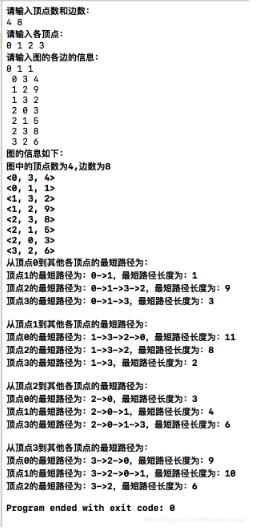
以上就是本文的全部内容,希望对大家的学习有所帮助,也希望大家多多支持。
以上是 C++求所有顶点之间的最短路径(用Dijkstra算法) 的全部内容, 来源链接: utcz.com/p/245134.html

